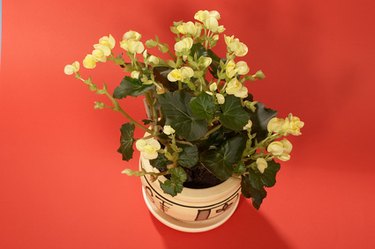
The right tools and methods help ensure success when planting flowers from seeds or seedlings. The necessary planting materials depend on whether you grow the flower outside or inside and in pots or in a bed. Starting the flower seeds indoors, then transplanting them outside gives the plant a head start on the growing season, A variety of materials can be used for both indoor and outdoor planting to ensure success.
Pots and Containers
Video of the Day
The age and planting method of the flower determine what type of container to use. Small seedling pots, cell-packs or flats provide a suitable growing container for planting seeds indoors for later outdoor transplanting. Plants to remain potted require a pot large enough to hold the mature flower. An 8- to 12-inch-diameter pot usually suffices. Pots and containers need drainage holes in the bottom so water doesn't collect inside the pots. Placing drip trays to catch the draining water under indoor flower pots prevents spills.
Video of the Day
Soil
Potting soil mixtures can contain peat, compost, vermiculite, perlite and soil. The amount of each material depends on the type of potting soil. Soilless mixes provide a sterile and well-draining choice for both seedlings and mature flowers. Mixes containing soil only work well for mature plants. A potting mix may already contain fertilizers, but those formulated for planting seeds usually come unfertilized.
Planting Amendments
Amendments, such as compost and fertilizer, help improve the soil quality in garden beds. Compost improves the quality of the soil, aids proper moisture retention and provides trace nutrients. A preplanting or "start fertilizer" application before or right at planting provides the nutrients the flowers need to produce a healthy root system and lush foliage growth. Most beds require a second fertilization at midseason to provide the nutrients for continued bloom.
Tools
Potted flowers require few tools. A narrow trowel helps dig planting holes to the correct depth in larger pots, but isn't necessary for small pots or seed starting. A hoe helps break up soil clods in garden beds and proves useful for cultivating and preventing weeds between the flowers once they are planted. Tall flowers with weak stems, such as peonies, may require stakes installed at planting to help support the flowers.
Mulching
Mulching improves the moisture level in the soil of outdoor beds. Organic mulches like bark nuggets, pine straw and wood chips provide an attractive mulch option for ornamental beds. Inorganic mulches, like plastic or landscape fabric, also prevent most weeds from growing when installed under organic mulch. Plastic and fabric mulch need to be applied to the bed prior to planting; organic mulches are applied after the flowers are planted.